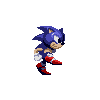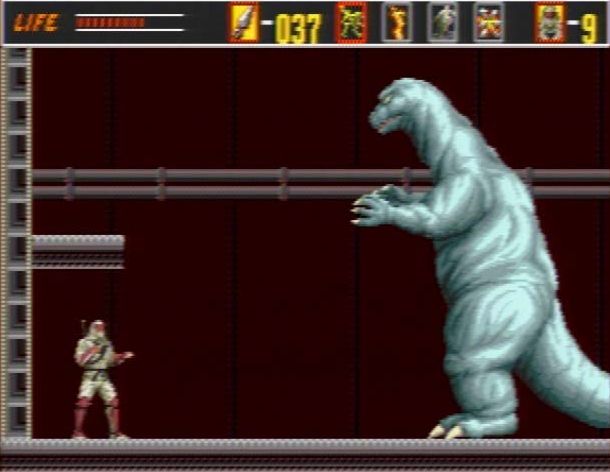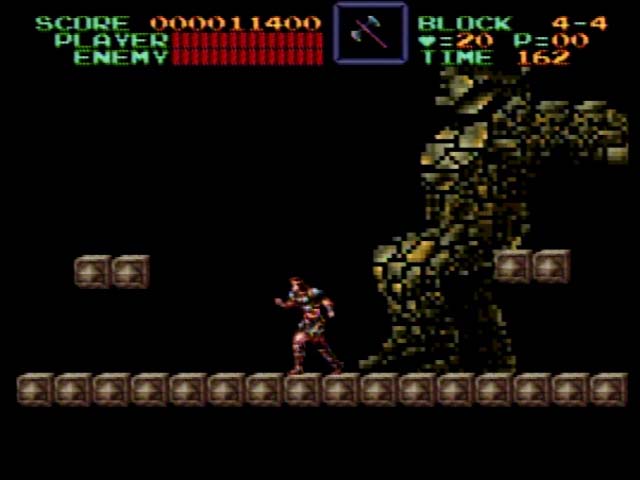Sega Genesis vs Super Nintendo
| Lifespan: | 1989-1996 |
|---|---|
| CPU: | 7.67 MHz 16/32-bit 680005 |
| Co-Processors: | 3.58 MHz Z80 (Audio/SMS): Can write to 68000's Work RAM6 Can access cartridge's ROM data7 Texas Instruments 76489 (PSG Audio): 4 Channels 8 Yamaha 2612 (FM Audio):9 6 Channels: One 8-bit Stereo Digital Audio Channel (DAC) replaces one FM channel 10 10 Audio Channels total Output Frequency: 52 kHz |
| Video Processing: | VDP Master System Compatibility 11 Hardware Shadow and Lighting 12 Direct Memory Access (DMA): Transfer Rate: 7.2 KB per 1/60th second13 |
| Resolutions: | 256x224, 320x224, 320x448 14 |
| Work RAM: | 64 KB |
| Video RAM: | 64 KB |
| Audio RAM: | 8KB |
| Color RAM: | 72 Bytes 15 |
| VSRAM: | 40 Bytes 16 |
| Colors On Screen: | 61 (30-75 in game, average 50) 17 18 |
| Color Palette: | 512 |
| Sprite Max & Sizes: | 80 sprites at 320x224 64 sprites at 256x22419 Sprite Sizes: 8x8, 8x16, 8x24, 8x32 16x8, 16x16, 16x24, 16x32 24x8, 24x16, 24x24, 24x32 32x8, 32x16, 32x24, 32x32 20 |
| Sprites per Scanline: | 20 at 320x224, 16 at 256x224 21 |
| Background Planes: | 2 layers with 16 colors per 8x8 pixel tile22 VDP handles scrolling as single planes, independently scrolling 8 line rows, and independently scrolling lines.23 Each 8 line row can can be displayed over or under others. 24 |
| Storage: | Cartridge up to 32 Mbit (4 MByte) Bankswitch method allows more than 32 Mbit of storage.25 |
| Lifespan: | 1991-1997 |
|---|---|
| CPU: | 3.58 MHz 16-bit 65c816 31 6502 Compatibility (unused) |
| Co-Processors: | SPC700 (Sound CPU) S-DSP (Sound Generator) 8 Digital Audio Channels Independent Stereo Panning (per channel)32 Filters for audio smoothing and echo 33 Compressed audio decoding 34 Output Frequency: 32 kHz |
| Video Processing: | PPU 1 PPU 2 (On the same chip) 35 Mozaic/Pixelation DMA Transfer Rate: 5.72 KB per 1/60th second shared by 8 Channels 36 HDMA Used for per line updates 37 |
| Resolution: | 256x224, 256x448, 512x224, 512x448 38 |
| Work RAM: | 128 KB |
| Video RAM: | 64 KB |
| Audio RAM: | 64 KB |
| Sprite RAM: | 512 + 32 bytes 39 |
| Color RAM: | 512 Bytes 40 |
| Colors On Screen: | 240-256 41 42 (90-150 average in game) |
| Color Palette: | 32,768 |
| Sprite Max & Size: | 128 sprites at: 8x8 & 16x16, 8x8 & 32x32, 8x8 & 64x64, 16x16 & 32x32, 16x16 & 64x64, 32x32 & 64x64, 16x32 & 32x64, 16x32 & 32x32 43 |
| Sprites per Scanline: | 32, 34 8x8 tiles, 256 sprite pixels per line 44 |
| Background Planes: | Eight Modes Numbered 0 - 7 4 (96-colors, 24 per background, 3/tile) 3 (two 120-colors, one 24-colors) 2 (120-colors) 2 (240-colors, 120-colors) 2 (240-colors, 24-colors) 2 (120-colors, 24-colors, interlaced) 1 (120-colors, interlaced) 1 (255-color, scaled, rotated, etc) 45 |
| Storage: | Cartridge up to 32 Mbit (4 MByte) • Tales of Phantasia (1995) (48 Mbit) • Star Ocean (1996) (48 Mbit) Average: 8 Mbit ('91), 16-32 Mbit ('92-'97) |
It is demonstrable that the SNES could actually display 2-3 times the colors on screen, while the Genesis could display 2-3 times the sprites and independently scrolling 2D planes. The SNES also could scale and rotate one 256 color plane, which could be made to look like large objects such as Bowser in Super Mario World or the Bomber in the first level of Contra IV. Alternately, games on the Genesis typically ran with less slowdown, featured faster scrolling levels, "tilted" sprites and backgrounds, and featured more custom special effects like scaling backgrounds and fully polygonal gameplay without any cart loaded processors. The Genesis' software effects are best seen in Contra Hard Corp, Castlevania Bloodlines, Batman and Robin, Ranger X, Sonic 3D Blast's bonus levels, LHX Attack Chopper, and Red Zone, for starters.
 Much as was the case with the NES library, the Super Nintendo saw full fledged releases for several years after the Genesis was discontinued. Combined with the SNES's dominance in Japan, the system consequently had a larger worldwide library by the end of its cycle. Because Square and Enix released their titles exclusively, the SNES has a greater number of RPGs available for it in the US.
Much as was the case with the NES library, the Super Nintendo saw full fledged releases for several years after the Genesis was discontinued. Combined with the SNES's dominance in Japan, the system consequently had a larger worldwide library by the end of its cycle. Because Square and Enix released their titles exclusively, the SNES has a greater number of RPGs available for it in the US.
 Despite superficial marketing tactics, the battle between NEC, Sega and Nintendo produced a wide variety of exclusive and critically acclaimed games for each platform. The Genesis has the largest library, and eventually gained the most third party support, of any Sega console. The Genesis' action genre is packed with arcade ports and unique home offerings like the Shinobi and Streets of Rage series. Yet the Genesis was also home to exclusive Sega RPGs like Sword of Vermillion, Phantasy Star 1-4, Shining in the Darkness, and Shining Force 1+2, amongst other notable series like Super Hydlide, Ys, and Dungeons & Dragons. Lunar the Silver Star, Lunar Eternal Blue and Vay, along with other Working Design’s localization efforts of Game Art’s games, were also released on the Sega CD.
Despite superficial marketing tactics, the battle between NEC, Sega and Nintendo produced a wide variety of exclusive and critically acclaimed games for each platform. The Genesis has the largest library, and eventually gained the most third party support, of any Sega console. The Genesis' action genre is packed with arcade ports and unique home offerings like the Shinobi and Streets of Rage series. Yet the Genesis was also home to exclusive Sega RPGs like Sword of Vermillion, Phantasy Star 1-4, Shining in the Darkness, and Shining Force 1+2, amongst other notable series like Super Hydlide, Ys, and Dungeons & Dragons. Lunar the Silver Star, Lunar Eternal Blue and Vay, along with other Working Design’s localization efforts of Game Art’s games, were also released on the Sega CD.
Regrettably, popular history uses the same measuring stick for all success stories. Sales is what most ill advised people look to in order to validate or invalidate their purchase decisions and sales is what the media is biased towards. The Genesis outsold the SNES in the US overall up until its discontinuation in 1995. The SNES managed to more than catch up in the two years before the Nintendo 64 took hold. The SNES clearly won out in sales worldwide and software sales in every region.
The truly important thing is that the war between the two companies produced some of the best games to ever be made. The game player that has only owned one system to the exclusion of the other has definitely lost out. What is worse is that in the new millenium the entire industry is bent toward anti-competative corporations. The preference for Mega-Corporations and Mega-Publishers are reflected by the media's excessively positive portrayal of the Super Nintendo.
- 1. Sam Pettus, "SegaBase Volume 3 - Megadrive / Genesis 'Sega MK-1601'," (January 23, 2007, accessed March 31, 2010) available from http://www.eidolons-inn.net/ (archive.org November 7, 2007).
- 2. Samuel N. Hart, A Brief History of Home Video Games: Sega Genesis, Geek Comix (archive.org June 16, 2008).
- 3. Legacy Sega Consoles: Sega Genesis, Sega of America (archive.org December 8, 2002).
- 4. PC Vs Console - Console Specs (4th Generation), (archive.org March 15, 2008).
- 5. Up to 32-bit processes internally, 16-bit data bus, Programer's Reference Manual M68000PM/AD Rev.1.
- 6. Are we sure MD Z80 can't write to M68K RAM? NCS does it....
- 7. Sega Genesis Manual.
- 8. 3 tone generators and 1 white noise, "Nemesis," GENESIS Technical Overview 1.00, (accessed April 1, 2010), 119.
- 9. Frequency Modulation is synthesized audio like PSG but considerably more complex.
- 10. Must be timed correctly in software to allow 5 FM Channels to play with digital audio (Street Fighter II:CE plays multiple digital audio channels simultaneously), "Nemesis," GENESIS Technical Overview 1.00, 92.
- 11. Charles MacDonald, E-mail || Homepage, Sega Genesis VDP documentation Version 1.5f (genvdp.txt) $01 - Mode Set Register No. 2, (August 10, 2000, accessed March 11, 2010), available from http://emudocs.org/?page=Genesis; internet.
- 12. MacDonald, genvdp.txt, 16.) Shadow / Hilight mode.
- 13. Speed at which data in RAM can be transferred to VRAM,"Nemesis," GENESIS Technical Overview 1.00, 45.
- 14. Interlaced double resolution mode, used in Sonic 2 splitscreen 2-player.
- 15. 64x9 bits, MacDonald, genvdp.txt, 9.) CRAM.
- 16. Vertical scroll RAM, 40x10 bits, MacDonald, genvdp.txt, 10.) VSRAM.
- 17. four 15-color palettes plus one background color
- 18. Direct 9-bit RGB (512 colors) available at half horizontal resolution, 160x224 or 128x224 visible, "Oerg866," "Nemesis" and "Chilly Willy," "Direct Color Demo using DMA," SpritesMind.net, accessed March 1, 2013, http://gendev.spritesmind.net/forum/viewtopic.php?t=1203.
- 19. MacDonald, genvdp.txt, 15.) Sprites
- 20. "Nemesis," GENESIS Technical Overview 1.00, 13.
- 21. MacDonald, genvdp.txt, Sprite Drawing Limitations.
- 22. Each tile shares colors from four 15 color palettes between the background and sprite layers, MacDonald, genvdp.txt, $0B - Mode Set Register No. 3.
- 23. MacDonald, genvdp.txt, $0B - Mode Set Register No. 3.
- 24. Hardware function of the VDP, MacDonald, genvdp.txt, 14.) Priority.
- 25.
"THE BANKSWITCHING MECHANISM",
SSFII GENESIS TECHNICAL INFORMATION. - 26. Samuel N. Hart, A Brief History of Home Video Games: Super Nintendo Entertainment System, Geek Comix (archive.org February 7, 2008).
- 27. Nintendo - Super NES - Detailed Specs, Nintendo of America (archive.org June 27, 2001).
- 28. PC Vs Console - Console Specs (4th Generation), (archive.org March 15, 2008).
- 29. Usenet, Rec.Games.Video, Ralph Barbagallo, SNES Hardware (January 19, 1992, accessed April 2, 2010) available from http://groups.google.com; internet.
- 30. Super NES Programming/SNES Specs, (October 29, 2007, archive.org June 14, 2008) available from http://en.wikibooks.org/wiki/Super_NES_Programming/SNES_Specs.
- 31. 1.56 MHz or 2.68 MHz in some software, Hardware.txt, available from http://www.mit.edu/afs/athena/activity/p/peckers/Programs/snes9x/solaris..., 65c816
- 32. SPC-700 Programming Information.
- 33. Anomie's S-DSP Doc version WIP (e-mail) (apudsp.txt), (October 13, 2005, accessed April 8, 2010).
- 34. "Ledi" and "Peekin", Super Famicomm Sound Manual NOA-SFX-04/15/90 (sfsound.txt), (October 15, 2001, accessed April 9, 2010), available from http://www.emudocs.org/?page=Super%20NES.
- 35. PPU is is called a single processor in all other documentation, Kevin Neviksti, SNES memory map and MAD-1 chip information (SNES_MemMap.txt), (accessed April 23, 2010) available from http://gatchan.net/uploads/Consoles/SNES/Flashcard/SNES_MemMap.txt.
- 36. 2.68MB divided by 8 (channels) divided by / 60 (frames per second), DMA occurs during VBLANK, Super NES Programming/SNES Specs, Direct memory access unit.
- 37. Uses DMA channels, Hardware.txt, H-DMA
- 38. 448 and 478 line modes are interlaced, Qwertie, Combined Registers Document (combined.txt), Screen mode/video select register [SETINI] (accessed on April 8, 2010).
- 39. Super NES Programming/SNES Specs, Video RAM.
- 40. Each color uses 2 bytes, David Piepgrass, Qwertie's SNES Documentation Plus DMA Revision 6 (2.1), Color Palettes, (1998, accessed April 5, 2010) available from http://emudocs.org (archive.org July 12, 2007).
- 41. eight 15 color background palettes, eight 15 color sprite palettes in most common graphic modes,
Charles MacDonald, E-mail || Homepage, SNES hardware notes (snestech.txt), CGRAM, (September 17, 2003, accessed March 11, 2010), available from http://www.emudocs.org/?page=Super%20NES - 42. 2048 Colors are technically possible using Direct Color Mode, Hardware.txt, Direct Colour Mode.
- 43. snestech.txt, Sprites
- 44. Super NES Programming/SNES Specs, Maximum onscreen objects (sprites).
- 45. 4 backgrounds limits colors per tile (8x8 pixels) to 3-colors whereas other modes are 15-colors per tile, adapted from Qwertie's SNES Documentation, Register $2105: Screen mode register (1b/W).
- Printer-friendly version
- 93265 reads

